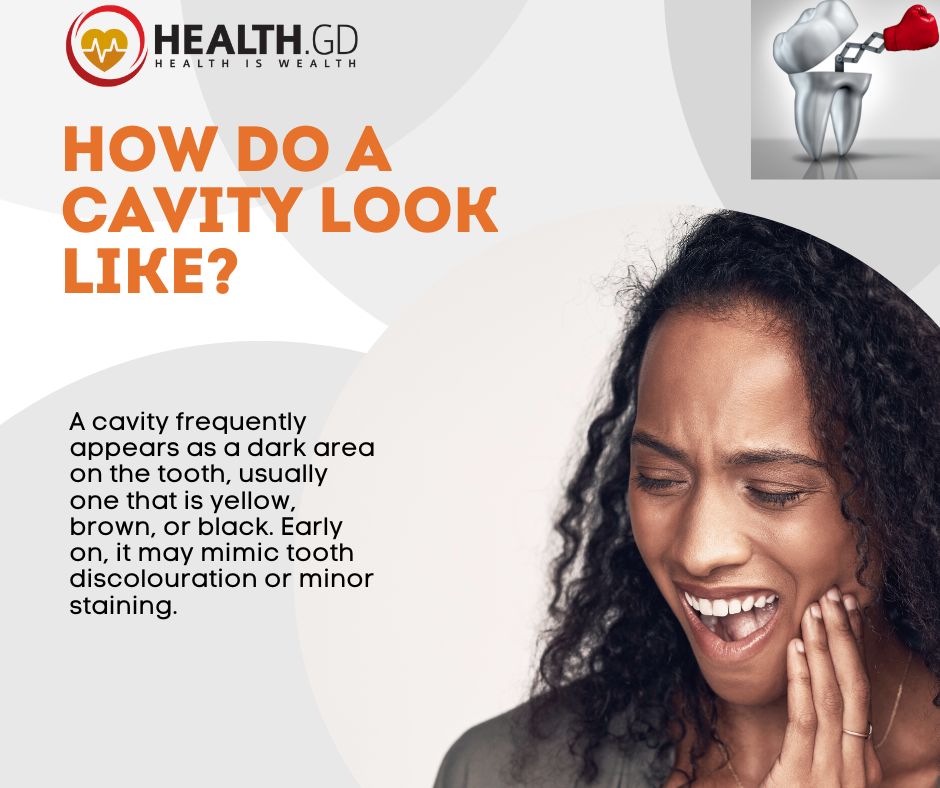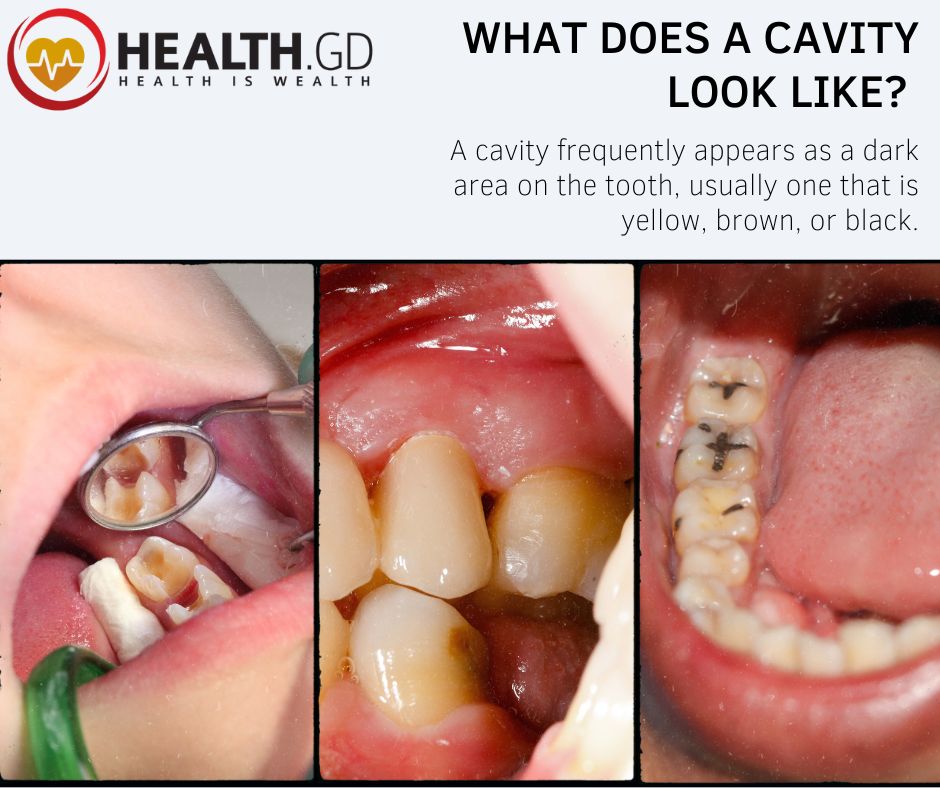Introduction

What Does A Cavity Look Like? To Answer this question, we must Know what is a cavity.
Cavities: Cavities can form when plaque and tartar (calcified plaque) accumulate on your teeth. The chewing surfaces of your rear teeth, molars, and the spaces between teeth are where cavities are most frequently discovered.
Formation of Cavity: They can also develop on the gum-line-nearing front teeth. You must schedule routine cleanings and examinations with your dentist because cavities aren’t always apparent to the unaided eye. Your dentist might utilise specialised equipment to find holes in the very early stages.
Problems Due to Cavity: Your tooth develops a hole due to a cavity. A niche might eventually cause your tooth to fall out if it is not addressed. Untreated cavities can also result in more severe side effects, including a tooth abscess or a potentially fatal bloodstream infection.
Locating Cavity: Each dental patient’s mouth has a somewhat varied appearance of cavities. To locate the teeth, we may need to look at them slowly and attentively or even utilise x-rays. Additionally, the patient’s symptoms are reviewed as indicators of where to seek.
What Does A Cavity Look Like?

A cavity frequently appears as a dark area on the tooth, usually one that is yellow, brown, or black. Early on, it may mimic tooth discolouration or minor staining. The holes in cavities enlarge and often become darker as they develop. Eventually, a little dot might nearly completely devour the tooth. To ensure that you aren’t developing cavities or already have them, you should keep an eye out for specific symptoms. Dental sensitivity when ingesting hot, cold, sweet, or acidic meals and beverages, you feel pain or discomfort.
Teeth with noticeable divots or pits: Cavities start as tiny holes in teeth and get bigger over time. Teeth with cavities may seem yellow, brown, or black in hue. An infection, which indicates the jam has reached the pulp of your tooth, is typically characterised by throbbing pain in your teeth.
Poor breath: When cavities are left untreated, the germs from the decay can result in bad breath. Your teeth’ fit may have changed: Your teeth can stop interacting like they once did if you have extensive tooth decay.
How Do A Dentist Fill Cavities?
Filling: The variety of filling materials accessible to dentists today means you may choose one that meets your cosmetic and economic needs, including being covered by dental insurance. These are the resources that are available to us. As a result, the majority of cavities are filled. Cast gold is durable and long-lasting, but it is also costly, takes a long time to put, and doesn’t match the colour of natural teeth.

Durable and reasonably priced, silver (amalgam) looks unnatural and takes up more room in the tooth. It also could contain traces of mercury. Tooth-coloured composite is the best option for blending teeth; however, it wears down more quickly and is more expensive than gold fillings despite being used on teeth with damage or chips. Porcelain, a costly yet stain-resistant material, is frequently used to make ceramics.
How Do You Prevent A Cavity?
Cavities can be prevented, and it’s not impossible. You may do several things to help avoid them and maintain oral health. You may be confident that you won’t develop cavities if you’re conscious of your dental health.
1. Limit Consuming meals that are High in sugar
You have to be conscious of the dietary groups you consume. Foods with much sugar can cause cavities. Limit your consumption of sweet foods and beverages. If you consume too much sugar, clean your teeth immediately and drink some water to flush the remaining sugar from your mouth.
2. Consume tooth-friendly foods
Your dental health is directly impacted by what you consume. Consuming a lot of fruits and vegetables might help maintain healthy teeth. They have vital vitamins and minerals that support good teeth. Additionally, fruits and vegetables promote salivation, which is essential for maintaining a healthy mouth.
3. Flossing
Daily flossing should be a priority for you, and young children may require assistance with this oral care task. Bits of food are removed by flossing correctly. Because cavities can develop on the sides of your teeth, flossing is crucial.
4. Rinsing
Washing and brushing your teeth with water or mouthwash can help eliminate any remaining food particles. It might still be helpful if you don’t currently have access to a toothbrush. Your dentist could advise fluoride or antibiotic rinse if you have specific dental requirements.
Conclusion
Consultation with Dentist: It might be challenging to detect a cavity in your mouth. Even dentists frequently need to examine patients in front of a mirror. However, you could notice a gap. Dental cavities may have overlapping symptoms and implications. Also, suppose you encounter any of the following. Therefore, in that case, you should schedule a dentist consultation immediately and avoid susceptible teeth to heat or cold.
A mouth or jaw crater or hole is referred to as swelling. Trouble chewing and swollen or bleeding gums may cause weight loss and malnutrition—moreover, pus around your mouth or teeth (indicates an infection or abscess). A hole or crater on a tooth that is visible or palpable is known as tooth chipping, cracking, or loss.
One must avoid tooth erosion from stomach acid in the mouth, and there are various simple techniques to treat acid reflux. If you suspect acid reflux, you should consult your doctor about heartburn. You’ll probably be offered advice on limiting your intake of foods that cause acid production and recommendations for over-the-counter drugs to do the same.
Regular Checkup: Lastly, to avoid cavities, scheduling routine cleanings and checkups at the dentist is essential. You can find little holes before they expand and cause much greater issues, enquire about novel therapies, and receive a thorough cleaning of your teeth.




